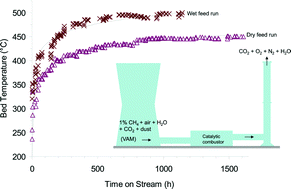Catalytic combustion of ventilation air methane (VAM) – long term catalyst stability in the presence of water vapour and mine dust†
Abstract
In this paper, we report new insights into the deactivation phenomenon of palladium based catalysts for catalytic combustion of ventilation air methane (VAM). It was found that the primary factor responsible for low temperature catalyst deactivation is the water vapour present in the feed stream. The influence of water vapour on VAM was examined by comparing the properties of fresh catalysts with catalysts following over 1000 h reaction time-on-stream. The techniques applied to characterize the catalysts included TPD, XRD, N2-isotherm adsorption, H2-chemisorption and XPS analyses. Alternating between dry and water vapour-saturated VAM feed disclosed ca. 50% reversible drop in activity. XPS analysis suggests an absence of a palladium hydroxide phase during the initial 2 h on stream, although prolonged exposure to the reactant leads to the formation of palladium hydroxide, which appears to match the progressive deactivation of the Pd/Al2O3 catalyst. Introduction of VAM dust (a mixture of fine coal, CaCO3 and aluminosilicate particles) causes a variation in catalytic activity originating from coal-dust ignition and the effect of chloride on the surface of the catalyst. In the presence of these inhibiting agents, an average methane conversion of higher than 75% over 1100 h was achieved at reaction temperatures below 600 °C.


 Please wait while we load your content...
Please wait while we load your content...